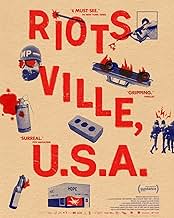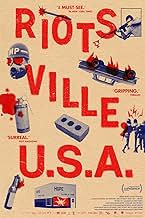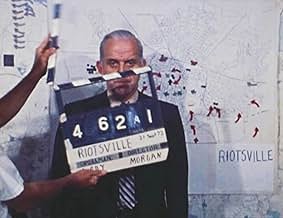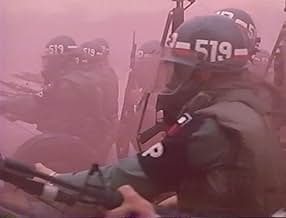Añade un argumento en tu idiomaWelcome to Riotsville, a fictional town built by the US military. Using all archival footage, the film explores the militarization of the police and creates a counter-narrative to the nation... Leer todoWelcome to Riotsville, a fictional town built by the US military. Using all archival footage, the film explores the militarization of the police and creates a counter-narrative to the nation's reaction to the uprisings of the late '60s.Welcome to Riotsville, a fictional town built by the US military. Using all archival footage, the film explores the militarization of the police and creates a counter-narrative to the nation's reaction to the uprisings of the late '60s.
- Dirección
- Guión
- Reparto principal
- Premios
- 4 premios y 10 nominaciones en total
Lyndon B. Johnson
- Self
- (metraje de archivo)
Otto Kerner
- Self - Chairman
- (metraje de archivo)
- (as Governor Otto Kerner)
Edward P. Morgan
- Self - PBL Chief Correspondent
- (metraje de archivo)
Robert Curvin
- Self - Former Chairman, Neward CORE
- (metraje de archivo)
Leonard Kowalewski
- Self - Newark Police
- (metraje de archivo)
John Harrington
- Self - Fraternal Order of Police
- (metraje de archivo)
- (as Sgt. John Harrington)
Albert Cleage
- Self
- (metraje de archivo)
- (as The Rev. Albert Cleage)
Alvin F. Poussaint
- Self - Tufts University
- (metraje de archivo)
- (as Dr. Albert Poussaint)
Fred Harris
- Self - Commission Member
- (metraje de archivo)
- (as Sen. Fred R Harris)
Dick Gregory
- Self
- (metraje de archivo)
Roger Mudd
- Self
- (metraje de archivo)
Robert Byrd
- Self
- (sonido de archivo)
- (as Senator Robert Byrd)
Jimmy Collier
- Self
- (metraje de archivo)
Frederick Douglass Kirkpatrick
- Self
- (metraje de archivo)
- (as Rev. Frederick Douglass Kirkpatrick)
Ronald Reagan
- Self
- (metraje de archivo)
Spiro Agnew
- Self
- (metraje de archivo)
- (as Gov. Spiro Agnew)
Strom Thurmond
- Self
- (metraje de archivo)
- (as Sen. Strom Thurmond)
Reseñas destacadas
An in depth review of the true nature of police escalation during civil unrest. All of which is remains painfully relevant even to this day.
I was able to view this during the virtual Sundance Festival.
The blatant and heavily institutionalized discrimination that exists from of birth of police is well displayed throughout this film.
It's unfortunate that this is still a problem today.
Only critique is the editing did feel a bit choppy intermixed with the quotes. Maybe could use another round of editing before wide distribution.
I was able to view this during the virtual Sundance Festival.
The blatant and heavily institutionalized discrimination that exists from of birth of police is well displayed throughout this film.
It's unfortunate that this is still a problem today.
Only critique is the editing did feel a bit choppy intermixed with the quotes. Maybe could use another round of editing before wide distribution.
Greetings again from the darkness. A couple of old sayings came to mind while watching this. "The more things change, the more they stay the same." This ties together what we see from the 1960's with what we've seen very recently in the U. S. Next would be, "You made your bed, now sleep in it." This references the manner in which our government reacted to civil unrest in the 1960s has affected our society for the past 50+ years.
Documentarian Sierra Pettingill utilizes only archival footage from TV (newscasts and talk shows) and military footage filmed during the era. The clips are edited in a way to tell the story of how the government responded to increased civil unrest, and how those responses not only made the situation worse, it also set the table for ongoing societal issues for decades to come.
Historical background includes President Lyndon Johnson forming the Kerner Commission (officially The National Advisory Commission on Civil Disorders), and how the resulting 700 page 1968 report did not provide the conclusions expected by the government. It warned of two societies - one white, one black, separate and unequal. The corresponding action items were deemed too expensive due to the ongoing Vietnam War. Instead an addendum suggested expanded federal funding for police ... that one hit home with politicians.
Much of the footage, as well as the film's title, comes from the model town constructed by the military at Fort Belvoir in Virginia. It's here where training sessions occurred with military personnel cast as rioters and law enforcement learned the approaches to quell the uprising. Unfortunately, most of these approaches involved law enforcement escalation during civil unrest, leaving us wondering which causes the most damage. We even see military leaders observing the drills from the grandstands, applauding and laughing in some parts. It's impossible not to notice that these are all white faces.
Further escalation and federal funding resulted in specialty tanks, and we see the training videos around this weapon. At its core, what we see is a simulated riot in a simulated city. It's easy to view this as training hate and power, rather than learning de-escalation techniques. Director Pettingill also includes clips from PBL (precursor to PBS) talk shows like "Civil Disorder". These shows, and their debates, caused Ford Motor Company to withdraw funding in 1969. The news clips from the 1968 Democrat and Republican conventions provide some insight into the reporting during this era. Especially biting is David Brinkley's response to Strom Thurmond's comments. The film's only weakness comes in the form of narration from Charlene Modeste. The words are simply too flowery or artsy for such subject matter. This is a film that urges you to feel the frustrations. It turns out "Law & Order" can be twisted by those in power.
Releasing in theaters and OnDemand beginning September 16, 2022.
Documentarian Sierra Pettingill utilizes only archival footage from TV (newscasts and talk shows) and military footage filmed during the era. The clips are edited in a way to tell the story of how the government responded to increased civil unrest, and how those responses not only made the situation worse, it also set the table for ongoing societal issues for decades to come.
Historical background includes President Lyndon Johnson forming the Kerner Commission (officially The National Advisory Commission on Civil Disorders), and how the resulting 700 page 1968 report did not provide the conclusions expected by the government. It warned of two societies - one white, one black, separate and unequal. The corresponding action items were deemed too expensive due to the ongoing Vietnam War. Instead an addendum suggested expanded federal funding for police ... that one hit home with politicians.
Much of the footage, as well as the film's title, comes from the model town constructed by the military at Fort Belvoir in Virginia. It's here where training sessions occurred with military personnel cast as rioters and law enforcement learned the approaches to quell the uprising. Unfortunately, most of these approaches involved law enforcement escalation during civil unrest, leaving us wondering which causes the most damage. We even see military leaders observing the drills from the grandstands, applauding and laughing in some parts. It's impossible not to notice that these are all white faces.
Further escalation and federal funding resulted in specialty tanks, and we see the training videos around this weapon. At its core, what we see is a simulated riot in a simulated city. It's easy to view this as training hate and power, rather than learning de-escalation techniques. Director Pettingill also includes clips from PBL (precursor to PBS) talk shows like "Civil Disorder". These shows, and their debates, caused Ford Motor Company to withdraw funding in 1969. The news clips from the 1968 Democrat and Republican conventions provide some insight into the reporting during this era. Especially biting is David Brinkley's response to Strom Thurmond's comments. The film's only weakness comes in the form of narration from Charlene Modeste. The words are simply too flowery or artsy for such subject matter. This is a film that urges you to feel the frustrations. It turns out "Law & Order" can be twisted by those in power.
Releasing in theaters and OnDemand beginning September 16, 2022.
It's unfortunate when a film has an important message to convey but does a poor job of saying what it has to say. That's the problem with this documentary about the policies and practices underlying government efforts to control violent civil disobedience in major US cities during the mid to late 1960s. It focuses on the training programs employed at US Army bases where model cities (called "Riotsville") were built to stage simulated disturbances used for instructing military and police forces on how to quell such outbreaks in line with official government policies. But the film goes beyond that, trying to explain why these incidents were occurring with increasing frequency at the time and why such extensive training measures had become necessary. In doing so, the picture examines the frustrations associated with, and subsequent reactions to, the issues of poverty, racism, police brutality, inequality and the impact of the Vietnam War, among others, principally in minority inner city communities. It tells this story using only archive footage from the time, drawn from television broadcasts and official US military training films. However, given the broad scope of this story, director Sierra Pettengill's third feature outing doesn't delve nearly deep enough into these issues, somewhat surprising given the wealth of material at the filmmaker's disposal. Nor does it tie the Riotsville project to these larger questions as well as it could, relying more on implication than connection. Moreover, this shallow, underdeveloped approach is further undercut by a number of poorly chosen video segments and others in desperate need of editing out extraneous content. Add to that far too many explanatory subtitles and a number of dull, overwritten voiceovers seeking to philosophically elaborate on its conclusions, and you've got a watered down presentation of material deserving to be delivered with a greater sense of hard-hitting urgency. This is the sort of film that should make audiences angry, not put them to sleep, but this offering does more to promote the latter than the former. This is a story that would have been better told through more skillful directorial hands for it to have the impact it requires. Unfortunately, that's not the case here.
I was excited to see this documentary when I first heard about it and sought it out, but in the end it left me bored and annoyed.
The director has access to some remarkable file footage, but doesn't seem to know what to do with it. Interspersed with that amazing footage are a series of overly arty flashing collages of ambient video (a close up of TV pixels for several minutes) coupled with grinding tuneless soundscapes and a laughable voice over that sounds like a cross between a bad poetry slam and a hilarious satire of an overly earnest podcast, right down to the slow, labored delivery and over-pronunciation (Think the "You Must Remember This" podcast)
The director also made a weird choice to not have voice narration outside of the arty collages; instead she has chosen like a hundred title cards in black rectangles in the middle of the screen. It becomes annoying pretty quickly since the file footage is so jaw droppingly interesting.
So many bad choices directorially. With the footage they had, this should have been a gimme, instead it's like a high school film students senior project with a fairly dumbed-down historical take.
Come for file footage; be prepared to fast forward through the long, boring "podcast" segments.
The director has access to some remarkable file footage, but doesn't seem to know what to do with it. Interspersed with that amazing footage are a series of overly arty flashing collages of ambient video (a close up of TV pixels for several minutes) coupled with grinding tuneless soundscapes and a laughable voice over that sounds like a cross between a bad poetry slam and a hilarious satire of an overly earnest podcast, right down to the slow, labored delivery and over-pronunciation (Think the "You Must Remember This" podcast)
The director also made a weird choice to not have voice narration outside of the arty collages; instead she has chosen like a hundred title cards in black rectangles in the middle of the screen. It becomes annoying pretty quickly since the file footage is so jaw droppingly interesting.
So many bad choices directorially. With the footage they had, this should have been a gimme, instead it's like a high school film students senior project with a fairly dumbed-down historical take.
Come for file footage; be prepared to fast forward through the long, boring "podcast" segments.
This film struggles with some fascinating archival footage and trying to stretch both the length and message of the film too broadly around that.
This country struggles with civil rights sadly over and over again, now to the point where the one thing uniting far too many citizens is an unwavering distrust of the government. Documenting protests is important in understanding both the strength and vulnerability of the not-always-so-United States. That said I feel like any assembly of mobs...protesters (also I guess anti-protesters generally few but vociferous) and then the police force can bring out the mob mentality on both sides.
In general color me wary of both, but especially the ones where everyone in the mob has a gun.
Anyways this film might best be served by watching the trailer or a sped-up or excerpted version of it. I assume the abridged version won't have the slow zoom and defocus on pixelated faces. Although that would do a disservice to DJ Rupture's excellent soundtrack work.
Looking forward... 1) Well I do think for all of the struggles, the arc or the USA does bend towards a better country...often painfully and painfully slowly.
2) The notion of test cities for police exercises is still going on afaik, didn't the former Blackwater corporation utilize them recently before they re-branded or whatever?
3) Sierra Pettengill might be an excellent resource for gathering archival footage for other directors' projects. I see she was part of the team for the Jarmusch documentary on the The Stooges (with Iggy that is, not Curly).
I struggle to recommend this, but with expectations lowered for less of an expose and more of an art collage meditation with occasional Gulf advertisements - it might be worth an hour of your time, although the running time is 1.5 hours.
This country struggles with civil rights sadly over and over again, now to the point where the one thing uniting far too many citizens is an unwavering distrust of the government. Documenting protests is important in understanding both the strength and vulnerability of the not-always-so-United States. That said I feel like any assembly of mobs...protesters (also I guess anti-protesters generally few but vociferous) and then the police force can bring out the mob mentality on both sides.
In general color me wary of both, but especially the ones where everyone in the mob has a gun.
Anyways this film might best be served by watching the trailer or a sped-up or excerpted version of it. I assume the abridged version won't have the slow zoom and defocus on pixelated faces. Although that would do a disservice to DJ Rupture's excellent soundtrack work.
Looking forward... 1) Well I do think for all of the struggles, the arc or the USA does bend towards a better country...often painfully and painfully slowly.
2) The notion of test cities for police exercises is still going on afaik, didn't the former Blackwater corporation utilize them recently before they re-branded or whatever?
3) Sierra Pettengill might be an excellent resource for gathering archival footage for other directors' projects. I see she was part of the team for the Jarmusch documentary on the The Stooges (with Iggy that is, not Curly).
I struggle to recommend this, but with expectations lowered for less of an expose and more of an art collage meditation with occasional Gulf advertisements - it might be worth an hour of your time, although the running time is 1.5 hours.
Selecciones populares
Inicia sesión para calificar y añadir a tu lista para recibir recomendaciones personalizadas
- How long is Riotsville, U.S.A.?Con tecnología de Alexa
Detalles
Taquilla
- Recaudación en Estados Unidos y Canadá
- 40.960 US$
- Fin de semana de estreno en EE. UU. y Canadá
- 5597 US$
- 18 sept 2022
- Recaudación en todo el mundo
- 44.392 US$
- Duración1 hora 31 minutos
- Color
Contribuir a esta página
Sugerir un cambio o añadir el contenido que falta

Principal laguna de datos
By what name was Riotsville, U.S.A. (2022) officially released in India in English?
Responde
























